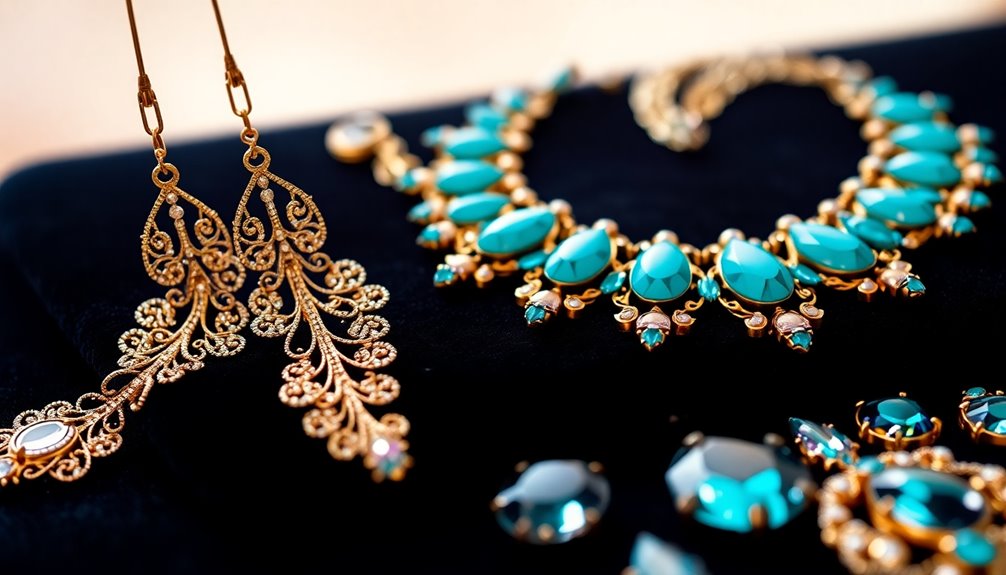Understanding gem cuts helps you see how skilled craftsmanship transforms rough stones into stunning jewelry. Beginner’s guides explain how different cuts, like brilliant or step, are designed to maximize light reflection and showcase color. Techniques such as faceting and polishing play key roles in creating brilliance and clarity. As you learn more about the history and evolution of gem cutting, you’ll appreciate the artistry behind each sparkling gem even more. Keep exploring to uncover the details behind these dazzling designs.
Key Takeaways
- Different gem cuts, like brilliant and step cuts, are designed to maximize light reflection and enhance gemstone brilliance.
- The history of gem cutting shows a progression from simple shaping to intricate faceting techniques.
- Proper polishing involves skilled control of abrasives and symmetry to reveal the stone’s full sparkle and beauty.
- Cutting styles are influenced by cultural significance and technological advancements, evolving over centuries.
- Selecting the right cut enhances a gemstone’s natural color, clarity, and overall visual appeal.

If you’re new to the world of gemstones, understanding the different cuts can seem overwhelming at first. Many begin their journey fascinated by the sparkle and beauty of polished stones but quickly realize there’s a lot more to it than just choosing a pretty gem. To truly appreciate the art, it’s helpful to learn about the history of gem cutting and the polishing techniques that bring out each stone’s unique brilliance. The history of gem cutting dates back thousands of years, where early artisans used rudimentary tools to shape rough stones into more refined forms, often driven by cultural significance and available technology. Over time, craftsmanship evolved from simple shaping to intricate faceting, with civilizations like the Greeks and Romans advancing the techniques that are still influential today. Modern gem cutting combines centuries of tradition with innovative methods, resulting in a vast array of cuts designed to maximize light reflection and enhance color.
When you start exploring different cuts, you’ll notice that polishing techniques are central to creating the brilliance you admire. These techniques involve more than just shining the surface; they require skillful control of abrasives, angles, and symmetry to produce a flawless finish. For example, the brilliant cut, often associated with diamonds, involves multiple facets precisely arranged to reflect light internally and externally, giving the stone its signature sparkle. To achieve this, cutters use specialized equipment and meticulous polishing processes, ensuring each facet is smooth and symmetrical. Other cuts like the emerald or step cut focus on clean lines and clarity, emphasizing the stone’s depth and color. The key to effective polishing is understanding how each cut interacts with light and applying the right techniques to enhance those effects.
Getting familiar with these polishing techniques also helps you understand why some stones cost more or sparkle more vividly. Proper polishing isn’t just about making a gem look good; it’s about unearthing its full potential. As you learn about different cuts, you’ll realize that each one requires specific skills and tools, often passed down through generations of gem cutters. Whether it’s a simple cabochon or a complex rose cut, the goal remains the same: to showcase the stone’s natural beauty. So, as you explore gem cutting, appreciate the craftsmanship behind each polished gem, recognizing the blend of history, skill, and artistry that transforms rough minerals into dazzling jewelry.
Frequently Asked Questions
What Is the Most Popular Gem Cut for Engagement Rings?
The most popular gem cut for engagement rings is the round brilliant cut. You’ll find it elevates the brilliance of precious stones, making them sparkle brilliantly. This cut has a rich gemstone history, dating back to the 19th century, and remains timeless for its maximized light reflection. When choosing an engagement ring, the round brilliant cut ensures your precious stone shines with unmatched brilliance and elegance.
How Do I Choose the Right Cut for My Gemstone?
To choose the right cut for your gemstone, consider the facet shapes that enhance its natural beauty and the gemstone proportions that maximize brilliance. Think about your personal style—do you prefer a classic round or a unique cushion shape? Also, evaluate how different cuts reflect light and complement your setting. By balancing these factors, you’ll find a cut that truly showcases your gemstone’s sparkle and character.
Are Certain Cuts More Suitable for Specific Gem Types?
Did you know that certain cuts can enhance a gemstone’s brilliance by up to 40%? Yes, some cutting techniques are more suitable for specific gem types. For example, round cuts maximize sparkle in diamonds, while emerald cuts emphasize clarity in emeralds. Understanding gem shape suitability helps you choose the right cut, ensuring your gemstone’s beauty is showcased perfectly. Always consider the gem’s natural features when selecting a cut.
How Do Cuts Affect a Gemstone’s Durability?
Cuts directly impact a gemstone’s durability by influencing its symmetry and how well it handles daily wear. Poor diamond symmetry can create weak points, making the gem more prone to chipping or cracking. During gemstone polishing, careful attention guarantees edges are smooth and balanced, enhancing strength. A well-cut gem distributes stress evenly, safeguarding it over time, so always choose cuts that prioritize symmetry and expert polishing for lasting durability.
What Are the Latest Trends in Gem Cutting Styles?
You’ll notice that futuristic designs are gaining popularity, featuring edgy, innovative cuts that push traditional boundaries. For example, some jewelers now incorporate eco-friendly techniques, like lab-grown gemstones and sustainable polishing methods, into their cutting styles. These trends emphasize both creativity and sustainability, appealing to eco-conscious consumers. Expect to see more geometric, unconventional shapes that blend modern aesthetics with environmentally responsible practices, shaping the future of gem cutting.
Conclusion
Don’t worry if you’re feeling overwhelmed—learning about gem cuts might seem complex at first, but you’ll get the hang of it with a little curiosity. Remember, every expert was once a beginner. With practice, you’ll start recognizing the beauty and craftsmanship behind each cut. So, keep exploring, asking questions, and enjoying the journey. Before you know it, you’ll see gems in a whole new light—and maybe even pick your favorite cut!










